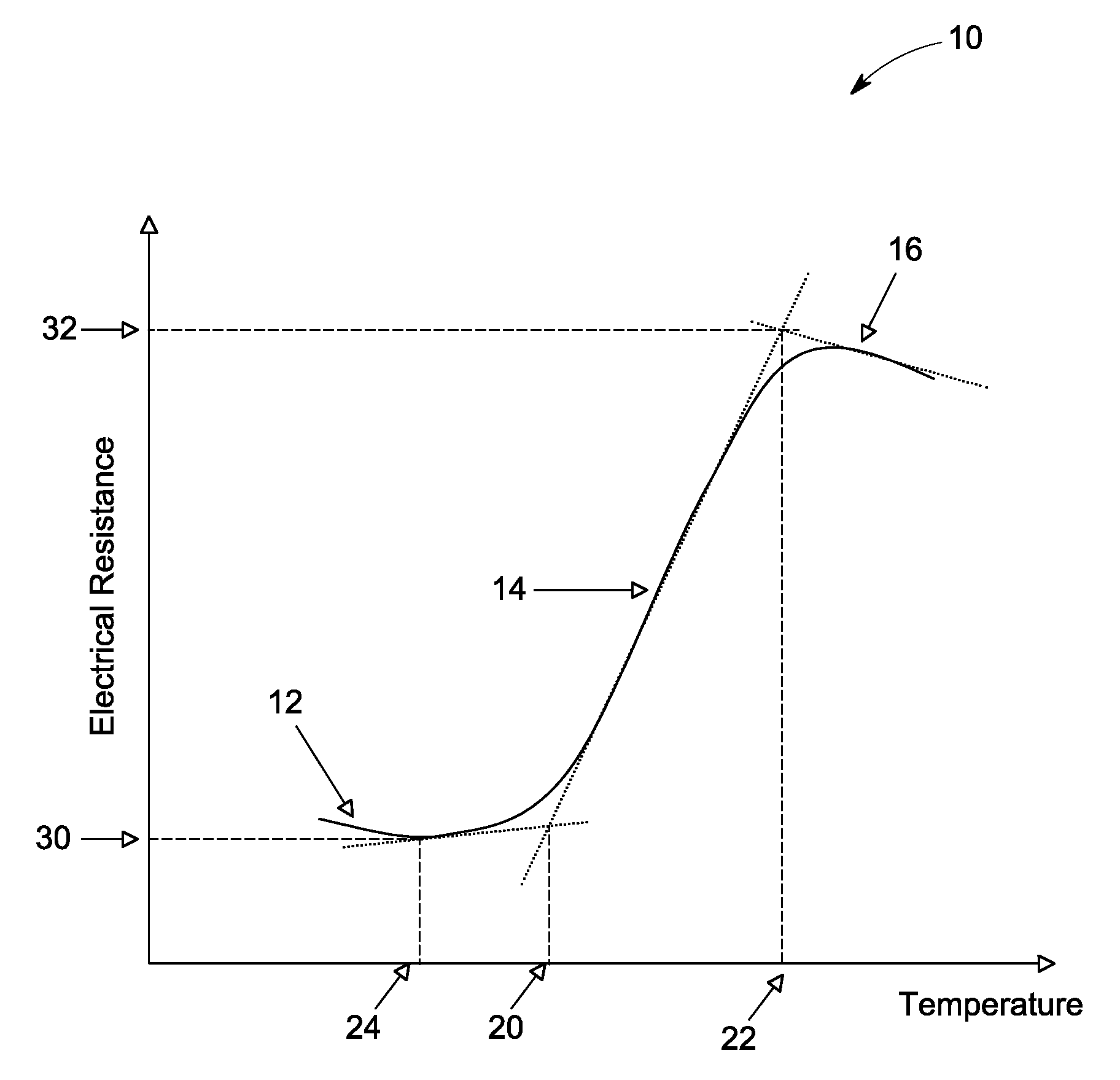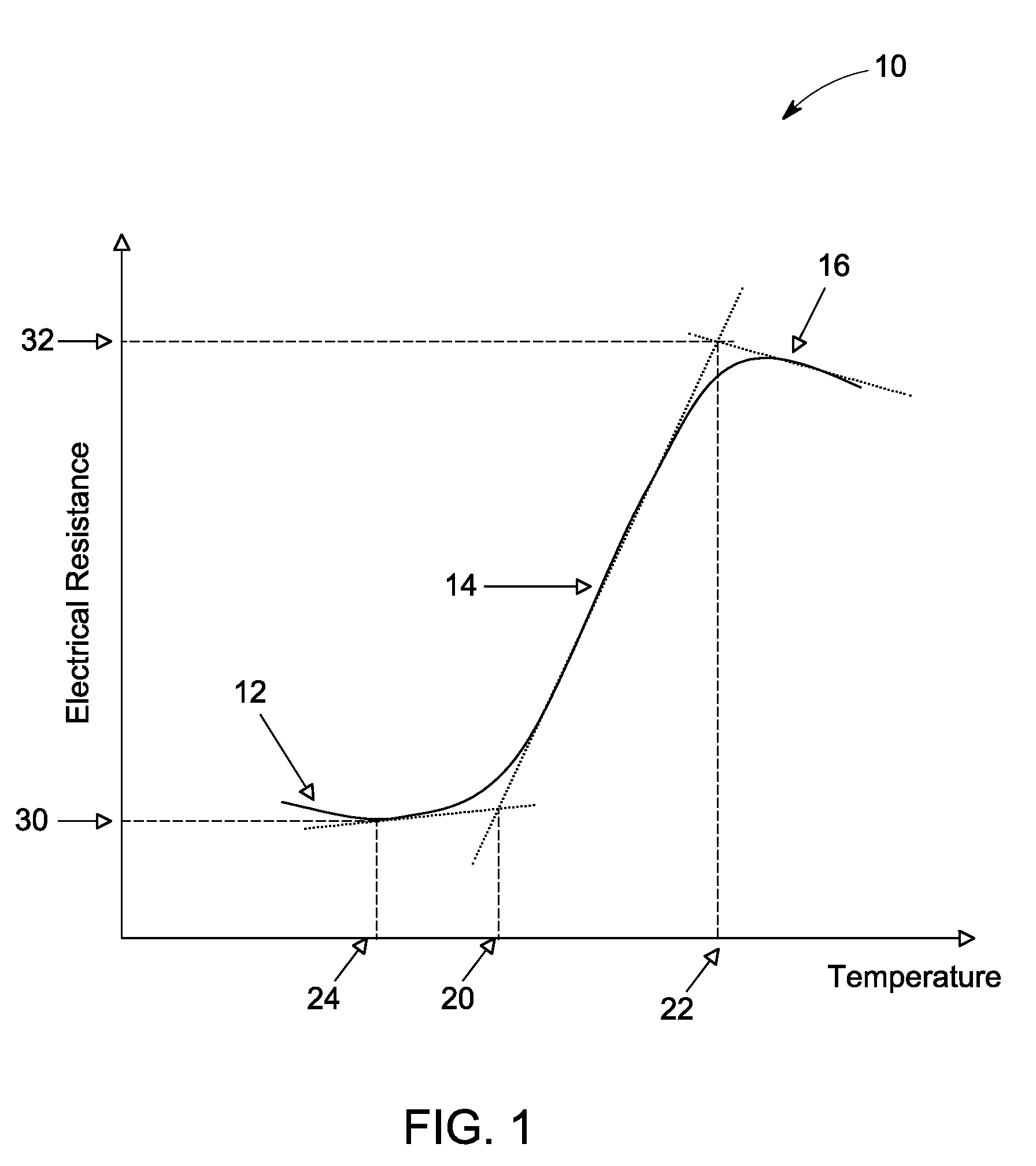Article and associated method
a technology of electrical conductivity and articles, applied in the direction of positive temperature coefficient thermistors, non-metal conductors, conductors, etc., can solve the problems of not being able to achieve the desired shape, mechanical property, mechanical property, etc., and achieve the desired shape and mechanical property. , the effect of reducing the resistance of the electrical conductivity composition
- Summary
- Abstract
- Description
- Claims
- Application Information
AI Technical Summary
Problems solved by technology
Method used
Image
Examples
example 1
[0098]Doping of BaTiO3 with three different donor dopants (La, Sb and Nb—) is carried out with different dopant concentrations, with and without manganese (Mn) as acceptor. BaTiO3 is also doped with Sb and Nb simultaneously. The doping formulations for La-doped BaTiO3 and Sb, Nb-doped BaTiO3 are shown in Table 1 and Table 2, respectively.
[0099]Doping of BaTiO3 is performed by a simple mixing method or a bar milling method. In the simple mixing method, measured amounts of dopants and BaTiO3 powder is mixed in a pestle and mortar with acetone as a solvent. The resulting mixed powder is air dried and then sintered in air at high temperature. In the bar milling method, 20 grams of BaTiO3 powder, along with the doping agents, is mixed with isopropyl alcohol (60 milliliters). The resulting mixture is ball milled for 8 hrs in a three roller ball-milling machine, using yttria stabilized zirconia milling media (YSZ, 80 grams). The ball-milled mixture is air-dried and then sintered in air. Si...
example 2
[0100]Samples 1, 2 and 3 are dispersed in a nylon-6 matrix to form composites with doped BaTiO3. Prior to melt mixing, nylon-6 powder is air dried in an oven at 150 degrees Celsius for 12 hours to eliminate any moisture-induced degradation. The composites are prepared in a laboratory-mixing machine (LMM) by melt mixing. Mixing is carried out at about 260 degrees Celsius at 80 percent rotor speed, for a duration of about 10 minutes. The melt-mixed mixture is injection molded to form Nylon-6 composites with La-doped BaTiO3 (Samples 10-12). The compounding formulations for three different atomic compositions (Sample Nos. 10-12) of La-doped BaTiO3 in Nylon-6 composites are shown in Table 3. The weight percentage of La-doped BaTiO3 in the polymeric matrix is in an amount in a range of from about 80 weight percent to about 90 weight percent.
TABLE 3Sam-pleAt. % ofLa—BaTiO3La—BaTiO3Nylon-6Nylon-6TotalNo.La(wt %)(g)(g)(wt %)(g)100.2853.40.6154110.3853.40.6154120.4853.40.6154
example 3
[0101]A second conducting filler, carbon black, is dispersed in the Nylon-6 polymeric matrix along with 0.3 at % La-doped BaTiO3. Two different concentrations of carbon black are used: 0.1 weight percent (with respect to total filler loading) and 0.2 weight percent (with respect to total filler loading). Assuming random distribution of carbon black and La-doped BaTiO3 in Nylon-6, at 0.2 wt % of carbon black (with respect to total filler loading) the effective loading of carbon black in nylon-6 reaches to 2.8 weight percent, which is closer to CB percolation level (3 weight percent) in nylon-6. The composites are prepared in a laboratory-mixing machine (LMM) by melt mixing. Prior to melt mixing, nylon-6 powder is air dried in an oven at 150 degrees Celsius for 12 hours to eliminate any moisture-induced degradation. Mixing is carried out at about 260 degrees Celsius at 80 percent rotor speed, for a duration of about 10 minutes. The melt-mixed mixture is injection molded to form Nylon-...
PUM
| Property | Measurement | Unit |
|---|---|---|
| current | aaaaa | aaaaa |
| current | aaaaa | aaaaa |
| voltage | aaaaa | aaaaa |
Abstract
Description
Claims
Application Information
 Login to View More
Login to View More - R&D
- Intellectual Property
- Life Sciences
- Materials
- Tech Scout
- Unparalleled Data Quality
- Higher Quality Content
- 60% Fewer Hallucinations
Browse by: Latest US Patents, China's latest patents, Technical Efficacy Thesaurus, Application Domain, Technology Topic, Popular Technical Reports.
© 2025 PatSnap. All rights reserved.Legal|Privacy policy|Modern Slavery Act Transparency Statement|Sitemap|About US| Contact US: help@patsnap.com



